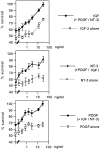Developing Schwann cells acquire the ability to survive without axons by establishing an autocrine circuit involving insulin-like growth factor, neurotrophin-3, and platelet-derived growth factor-BB
- PMID: 10234017
- PMCID: PMC6782711
- DOI: 10.1523/JNEUROSCI.19-10-03847.1999
Developing Schwann cells acquire the ability to survive without axons by establishing an autocrine circuit involving insulin-like growth factor, neurotrophin-3, and platelet-derived growth factor-BB
Abstract
Although Schwann cell precursors from early embryonic nerves die in the absence of axonal signals, Schwann cells in older nerves can survive in the absence of axons in the distal stump of transected nerves. This is crucially important, because successful axonal regrowth in a damaged nerve depends on interactions with living Schwann cells in the denervated distal stump. Here we show that Schwann cells acquire the ability to survive without axons by establishing an autocrine survival loop. This mechanism is absent in precursors. We show that insulin-like growth factor, neurotrophin-3, and platelet-derived growth factor-BB are important components of this autocrine survival signal. The secretion of these factors by Schwann cells has significant implications for cellular communication in developing nerves, in view of their known ability to regulate survival and differentiation of other cells including neurons.
Figures










Similar articles
-
Why do Schwann cells survive in the absence of axons?Ann N Y Acad Sci. 1999 Sep 14;883:109-15. Ann N Y Acad Sci. 1999. PMID: 10586236 Review.
-
Schwann cells as regulators of nerve development.J Physiol Paris. 2002 Jan-Mar;96(1-2):17-24. doi: 10.1016/s0928-4257(01)00076-6. J Physiol Paris. 2002. PMID: 11755779 Review.
-
Platelet-derived growth factor-BB supports the survival of cultured rat Schwann cell precursors in synergy with neurotrophin-3.Glia. 2000 May;30(3):290-300. doi: 10.1002/(sici)1098-1136(200005)30:3<290::aid-glia8>3.0.co;2-6. Glia. 2000. PMID: 10756078
-
Control of Schwann cell survival and proliferation: autocrine factors and neuregulins.Mol Cell Neurosci. 1998 Oct;12(3):141-56. doi: 10.1006/mcne.1998.0706. Mol Cell Neurosci. 1998. PMID: 9790735
-
The neuron-glia signal beta neuregulin induces sustained CREB phosphorylation on Ser-133 in cultured rat Schwann cells.Mol Cell Neurosci. 1998 Apr;10(5-6):309-22. doi: 10.1006/mcne.1998.0662. Mol Cell Neurosci. 1998. PMID: 9604209
Cited by
-
Schwann cell-specific ablation of laminin gamma1 causes apoptosis and prevents proliferation.J Neurosci. 2005 May 4;25(18):4463-72. doi: 10.1523/JNEUROSCI.5032-04.2005. J Neurosci. 2005. PMID: 15872093 Free PMC article.
-
The Role of Sensory Innervation in Homeostatic and Injury-Induced Corneal Epithelial Renewal.Int J Mol Sci. 2023 Aug 9;24(16):12615. doi: 10.3390/ijms241612615. Int J Mol Sci. 2023. PMID: 37628793 Free PMC article. Review.
-
Ponatinib promotes a G1 cell-cycle arrest of merlin/NF2-deficient human schwann cells.Oncotarget. 2017 May 9;8(19):31666-31681. doi: 10.18632/oncotarget.15912. Oncotarget. 2017. PMID: 28427224 Free PMC article.
-
Human Schwann-like cells derived from adipose-derived mesenchymal stem cells rapidly de-differentiate in the absence of stimulating medium.Eur J Neurosci. 2016 Feb;43(3):417-30. doi: 10.1111/ejn.13055. Epub 2015 Sep 18. Eur J Neurosci. 2016. PMID: 26309136 Free PMC article.
-
Schwann Cells: Development and Role in Nerve Repair.Cold Spring Harb Perspect Biol. 2015 May 8;7(7):a020487. doi: 10.1101/cshperspect.a020487. Cold Spring Harb Perspect Biol. 2015. PMID: 25957303 Free PMC article. Review.
References
-
- Alessi DR, Cuenda A, Cohen P, Dudley DT, Saltiel AR. PD 098059 is a specific inhibitor of the activation of mitogen-activated protein kinase kinase in vitro and in vivo. J Biol Chem. 1995;270:27489–27494. - PubMed
-
- Barres BA, Hart IK, Coles HSR, Burne JF, Voyvodic JT, Richardson WD, Raff MC. Cell death and control of cell survival in the oligodendrocyte lineage. Cell. 1992;70:31–46. - PubMed
-
- Barres BA, Jacobson MD, Schmid R, Sendtner M, Raff MC. Does oligodendrocyte survival depend on axons? Curr Biol. 1993a;3:489–497. - PubMed
-
- Barres BA, Schmid R, Sendtner M, Raff MC. Multiple extracellular signals are required for long-term oligodendrocyte survival. Development. 1993b;118:283–295. - PubMed
Publication types
MeSH terms
Substances
Grants and funding
LinkOut - more resources
Full Text Sources
Other Literature Sources
